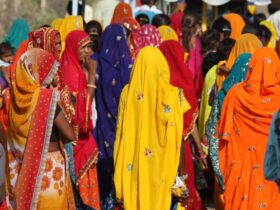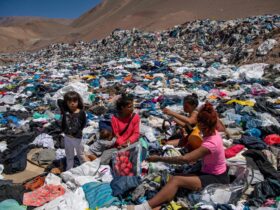LOS ANGELES — The development of new vaccines and alternative COVID-19 treatment options have remained highly relevant public health issues as hopes of the pandemic’s imminent end seem further and further away. Many countries are looking to the growing base of research around therapeutics that treat those already infected; this research is often easier and cheaper to distribute than vaccinations. Take, for example, the Australian government’s purchase of 300,000 doses of Molnupiravar, a COVID-19 antiviral drug manufactured by Merck.
Last month, the Rosalind Franklin Institute similarly released results of a study demonstrating the potential for llama-derived nanobodies to be developed into nasal sprays that could reduce the severity of COVID-19 symptoms and neutralize variants with lower production costs than injectable vaccines, pending human clinical trials.
This special focus on llamas — in addition to inspiring hope for the future of respiratory infection prevention and treatment — creates space for a conversation about the global inequities in the use of natural genetic resources. Particularly in Latin America, these potential solutions may expand public health justice.
With new variants and stagnating vaccination rates, even wealthy industrial countries have not been spared from rising COVID-19 rates and stuttering reopening measures. However, South American countries like Peru and Bolivia have faced even more dire circumstances — Peru has experienced the highest COVID-19 death rate per capita in the world, and only 30% of Bolivia’s population is fully vaccinated.
These two countries also make up the bulk of the Altiplano, an Andean plateau home to many indigenous and rural communities. In these parts of Peru and Bolivia, pandemic recovery disparities are magnified at the level for their most marginalized populations. For example, in Puno, a Peruvian region occupied by an indigenous majority and the largest city in the Southern Altiplano, only about 22% of the population has been vaccinated — 10% lower than the national rate. In rural parts of La Paz, the region home to Bolivia’s legislative capital, vaccine hesitancy is rampant. About half of all households offered vaccines rejected them for religious or safety concerns.
Both these issues in supply chain distribution and public mistrust have had a tremendous impact on the continual devastating effects of the pandemic in the Altiplano’s diverse rural and urban communities. Thus, a solution will require a unique approach addressing low supply numbers and historically-grounded mistrust in modern medicine.
The Rosalind Franklin Institute’s study would appear to be just that: a jumping-off point for utilizing Peru and Bolivia’s natural genetic resources for greater public health and economic benefit. Llama herding and farming have a cultural and historical significance in the region. Andean indigenous communities have domesticated the animals for millenia, making possible (arguably) the existence of such nanobodies. As one of the only productive forms of agriculture in the Altiplano’s harsh climate, llamas continue to constitute a major form of economic activity for Altiplano inhabitants.
And for decades, international organizations such as the UN’s International Fund for Agricultural Development have demonstrated the benefit of improved management practices on the socioeconomic welfare of farmers, particularly women and indigenous groups. Why not seek out the region with thriving llama populations to better understand the full utility of these nanobodies, while also providing camelid farmers additional economic opportunities?
What stands in the way is a complex set of obstacles, rooted in the historical and technological exclusions of Latin America and the rest of the Global South from the cooperative development that has facilitated the medical advancements of the wealthy developed world. The foundation “llama biocapital” was built on blood samples from camels in Mali and Morocco, but most research into the biotechnology of llamas has concentrated patents in countries like Belgium, the Netherlands and the United Kingdom.
Santiago Pastor Soplín, a research professor at Lima’s Scientific University of the South, notes that similar innovations in the use of natural plants like camu camu, achiote and agave have created patent-based barriers for access from their countries of origin. In this context, the need for international cooperation from countries able to establish patents towards regions that have produced base resources becomes highly relevant.
In tandem, moving toward a more equitable pandemic recovery will necessitate consideration of how Peru and Bolivia, as well as other Latin American economies, have been positioned in global supply chains to prioritize resource extraction over technological investment. Peru and Bolivia’s most profitable industry is mining, which often places a heavy burden on local environments, resources and income stability to the greater benefit of the nations that will receive those exports than the ones providing them. While the natural resources of the Altiplano could hypothetically provide an incredibly valuable fountain of biodiversity, Peru and Bolivia spend only 0.1% and 0.2%, respectively, of their GDP on research and development.
The Rosalind Franklin Institute is currently seeking funding to continue research in human clinical trials, the next step in determining whether the nasal spray will be a feasible treatment option for both COVID-19 and future disease management. Peru and Bolivia should have a place in llama nanobody research as it stands poised to become a key subject in the future of biocapital and biotechnology.
Development of natural resources valuing the inclusion of their nations of origin as beneficiaries is a necessary remedy towards addressing gaps in public health infrastructure exacerbated by the legacies of colonial extraction. If this pandemic has taught nations anything, it should be that this is a crucial step towards the future of effective global disease prevention.
Public-private partnerships between these Altiplano governments, research and development leaders and pharmaceutical manufacturers can help begin to diversify economies and ensure that the driving forces of economic policy are not merely elite interests, which will often sideline the needs of marginalized indigenous and rural groups. Incorporating these communities in such processes can also ease anxieties around biotechnology’s development and provide alternative forms of treatment that still reduce public health risks.
Ultimately, llamas can offer an invaluable insight into why shortcomings in opportunity and access to medical technology should be of both national and international concern. Peru and Bolivia must make serious efforts to prioritize transnational medical cooperation and establish legal protection of intellectual property and resource access.
For example, the Peruvian National Health Institute last year funded a project with a Peruvian research team based on nanobodies findings from the United States and Belgium. Continuing the information exchange channels that made such a study possible with the leaders in llama biotechnology development will mean more patents coming out of the Andean region. Additionally, the international community and its capacity for research, development and manufacturing are also responsible for engaging in inclusive practices that respect the bioheritage of oft-sidelined populations. A willingness to extend patent rights on present findings will be the most basic level.
Finally, international financing will be crucial in the face of massive government budget cuts in Latin America to ensure scientists have reliable access to federal funding. The future of “llama pharma” still has room for many participants. Still, it will take an intentional approach to ensure all who have contributed to the llama’s promising capabilities are included.







